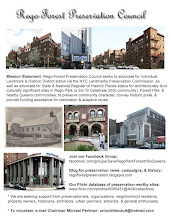Locals
have the chance to get creative and feel like an urban planner. As part of an
initiative to encourage citywide residents to play an active role in the
beautification and versatility of citywide parks, the Department of Parks and
Recreation (NYC Parks) launched the “Parks Without Borders” program in November,
and began seeking requests, where the public can log suggestions for
improvements on interactive maps through www.nycgovparks.org/planning-and-building/planning/parks-without-borders
The program’s goal is to make park entrances more inviting,
boundaries greener with enhanced sight lines and cozier with furnishings, and integrate
underutilized park-adjacent spaces into ones the community can call their own.
 |
| Friends of MacDonald Park with founder Steve Melnick in the footsteps of Captain Gerald MacDonald Statue, September 2015 |
As communities
plan their future, it is imperative to rediscover how such parks in Forest
Hills and Rego Park bear historic ties to their neighborhood. MacDonald Park, a
green oasis along the vibrant Queens Boulevard between Yellowstone Boulevard
and 70th Road, was named on April 25, 1933 after Captain Gerald
MacDonald (1882 – 1929), a WWI veteran from Forest Hills. He was an officer of
engineers at the Battle of Meuse-Argonne and erected bridges and dug trenches.
On May 26, 1934, a bronze Gerald MacDonald statue was dedicated to those who
served in the war. In 1964, U.S. Attorney General Robert F. Kennedy addressed
an audience of 700. This is also the site of Forest Hills Tree Giveaways and
the 112th Precinct’s Night Out Against Crime.
 |
| Captain Gerald MacDonald Statue under stately shade trees, 2008, Photo by Michael Perlman |
Forest
Hills resident Steve Melnick, founder of “Friends of MacDonald Park” (www.facebook.com/MacDonaldPark) explained, “Council Member Karen Koslowitz allocated $6,000 for
MacDonald Park, and we received an $800 capacity fund grant from the City Parks
Foundation and Partnerships for Parks, which will be used for tools and
plantings.” Melnick submitted a Parks Without Borders request. He explained,
“The entranceways need to be more open and inviting, and benches, tables, and
bike racks could be added to bring more people into the park. The cracked sidewalks
need to be reconstructed and LED lighting would improve security.” He also
suggested a senior and children’s butterfly garden, children's events such as
reading and puppet shows, musical events, and yoga.
 |
| Council Member Arthur J Katzman & Marcia Katzman Allen, Courtesy of Marcia Katzman Allen |
Another generously sized park is Yellowstone
Park on Yellowstone Boulevard between 68th Avenue and 68th
Road, which includes the Arthur J.
Katzman Playground. Council Member Arthur Katzman (1904 – 1993) whose nickname
was “the conscience of city government,” served City Council for 29 years. When
the land was slated for residential development, he advocated for the creation
of a park, which opened on May 27, 1968.
After the Parks Without Borders program was unveiled, another advocate came
forward. Forest Hills resident Alexa Weitzman founded the grassroots
organization, “Yellowstone Park Alliance” (www.facebook.com/YellowstoneParkQueens), and has since met with a NYC Parks representative. She
explained, “This is a vibrant mixed-use park, and there’s always room for more
greenery. It’s nice seeing grass, lots of open space, and maybe even a gazebo.”
Her wish list also includes additional plantings, benches, resurfacing the
bleachers in the basketball courts, and asking local dog owners how the trails
can be upgraded. Prior to coordinating the alliance, she launched a petition which
references three gates that open directly onto city streets. She stated,
“Allowing these gates to open and close and installing locking mechanisms would
create a much safer play space.” In addition, she envisions introducing lower
fences to make the park more inviting.
 |
| Leo Ehrenreich in 1949, Courtesy of Community Board 6 |
Ehrenreich-Austin
Playground between 76th Avenue and 76th Drive on Austin
Street also merits sprucing up, and residents now have a chance to follow in
the footsteps of Leo Ehrenreich (1882 – 1962). Under his “one-man civic
association,” he advocated for Forest Hills and Kew Gardens playgrounds, and
the park plot was acquired on May 2, 1947 after Parks Commissioner Robert Moses
and Queens Borough President George Harvey were receptive to his petition.
 |
| Ehrenreich-Austin Playground in 2009, Photo by Michael Perlman |
This
generation has another Forest Hills-based visionary named Amy Long, who founded
“Earth Citizens Club for Ehrenreich-Austin Playground.” She explained, “I would
like to see our parks become a center for community events such as performances,
a venue for arts and culture, and educational activities to promote ecological
mindfulness and sustainable living; especially now when climate change and the
environment is such an important focus.”
The grassroots group submitted ideas to Parks Without Borders, which
included minimizing the fence, restructuring benches, and introducing a central
arts installation and/or a mural. To date, the group has planted daffodils,
launched a cleanup, and coordinated Family Yoga Fun Day last August.
Other
local parks with historical ties awaiting public input include Federoff
Triangle, Real Good Park, World’s Fair Playground, Lost Battalion Playground, Russell
Sage Playground, Annadale Playground, Plaza 67, Horace Harding Playground, Pebblestone
Triangle, Fleetwood Triangle, Willow Lake Playground, and The Painter’s
Playground.
“Over
300 volunteer hours were devoted just to MacDonald Park in 2015,” said Melnick,
who indicated that such a commitment by locals coupled with the city’s Parks
Without Borders program has the makings of a success story.
A modified version of this article appears in the Forest Hills Times: www.foresthillstimes.com/view/full_story/27040805/article-Help-improve-your-local-park





